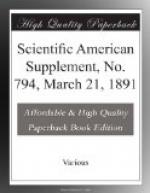The carbureted water gas has a smell every bit as strong as coal gas, and a leak would be detected with equal facility by the nose; and I think you will agree with me that the cry raised against the use of carbureted water gas, for this reason, is one of the same character that hampered the introduction of coal gas itself at the commencement of this century.
We must now turn to the chemical actions which are taking place in the generator of the water gas plant, and these are more complex in the case of the Van Steenbergh plant than in those of the Lowe type, and, for that reason, yield a gas of more satisfactory composition.
Taking gas as made by the Lowe or Springer process, and contrasting it with the Van Steenbergh gas, we are at once struck by several marked differences.
In the first place the hydrogen is far higher and the marsh gas or methane lower in the Van Steenbergh than in the Lowe process, this being due to the sharper cracking that takes place in the short column of cherry red coke, as compared with the lower temperature employed for a longer space of time in the Lowe superheater. Next we notice a difference of 10 per cent. in the carbon monoxide, which is greatly reduced in the Steenbergh generator by the carbon monoxide and marsh gas reacting on each other as they pass over the red hot surface of coke with formation of acetylene, which adds to the illuminants, this action also reducing the quantity of marsh gas present.
Lowe Van Steenbergh gas. gas.
Hydrogen..................... 27.14 46.75 Marsh gas.................... 25.35 11.27 Carbon monoxide.............. 26.84 18.65 Illuminants.................. 14.63 7.59 Ethane....................... ---- 6.82 Carbon dioxide............... 3.02 0.50 Oxygen....................... 0.15 0.17 Nitrogen..................... 2.87 8.25 ------ ------ 100.00 100.00
In the illuminants, if we add the higher members of the methane series present to the olefines, we see they are about equal in each gas, while the low percentage of nitrogen in the Lowe gas is due to more careful working, and could easily be attained with the Van Steenbergh plant by allowing the first portion of water gas to wash out the producer gas before the hopper on top is closed.
The cracking of the naphtha by the red hot coke is undoubtedly a great advantage, for, as I have pointed out, the cracking of rushing petroleum is an exothermic reaction, so that the coke at the top of the generator gets hotter and hotter, and it is no unusual thing to see the coke at the beginning of the make cherry red at the bottom and dull red at the top, while at the end of the make it is almost black at the bottom and cherry red at the top, in this way attaining the same advantage in working that the Springer and Loomis do by their down blast, that is, having the fuel at its hottest where the gas finally leaves it, so as to reduce the quantity of carbon dioxide, and so lessen the expense of purification.




